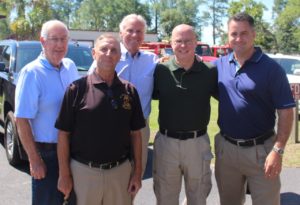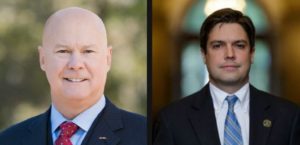MARION COUNTY, S.C. – Something special happened in Marion County, last month when hundreds of volunteers descended on the small town of Nichols, S.C. They were there to do the dirty work of clearing and cleaning ditches along the roadways in the flood-ravaged community. It was the first full-fledged demonstration of Gov. Henry McMaster’s S.C. Floodwater Commission in action; and it was a remarkable show of support by South Carolinians from across the state for their fellow citizens.

(left-to-right) Maj. Gen. George Goldsmith, Col. Steve Vitali, Gov. Henry McMaster, S.C. Floodwater Commission Chairman Tom Mullikin, and Col. Bill Connor.
Nichols had been flooded twice since 2016. First during Hurricane Matthew, then Hurricane Florence. Last Sept., approximately four-to-six feet of water spilled over from nearby rivers, blanketing the area and devastating residents who had just managed to rebuild from the flooding of 2016.
Like many flood-impacted communities, the problem is deferred maintenance of existing drainage systems. When debris is present to the extent it was in Nichols, there is and was nowhere for the water to go except into the town.
The June 15 volunteers – including Gov. McMaster, Lieutenant Gov. Pamela Evette, U.S. Congressman Tom Rice, three state legislators, four mayors and approximately 100 members of the S.C. State Guard – began removing everything from tires to sofas from Nichols’ roadside drainage and canal systems. The impact was immediate. By day’s end, volunteers had cleared 25,000-feet of roadside drainage, another 1.5 miles of canal, and they had replaced a huge subsurface drainage-pipe.
The S.C. Floodwater Commission is historic; bringing together stakeholders from across the spectrum of government, academia, law enforcement, the military and the non-profit sector to analyze and address the flooding issue comprehensively. The Commission consists of ten task forces, each with a different focus area everything from artificial reef systems to economic development.
For six months, the Commission has synced-up mapping data, met with engineers, identified infrastructural weaknesses and planned for big “moonshot” ideas. Each task force is now in the process of submitting a draft report which will present a comprehensive picture of the problems faced and solutions needed.
In a separate event following the Nichols cleanup, the group converged in nearby Sellers. Like Nichols, Sellers had been ravaged by flooding. Nearly all of the 40 homes within city limits have been significantly damaged. Many people have left, though most have opted to stay.
Yet, in what can only be described as a joyous occasion, Commission members converged on Sellers to hear the concerns of residents and offer their support while others planted the first of 500 trees which will offset stormwater and aid in groundwater infiltration, reducing the potential for flooding, erosion and runoff.
Sellers, like many other communities, will need more resources – and no small amount of resolve. But compassion goes a long way, and the spirit of volunteerism witnessed last month proved that our best resiliency strategy is our people. This is how government is supposed to work.

– John Cleveland is director of policy and external communications for Gov. McMaster.



 RSS - Posts
RSS - Posts